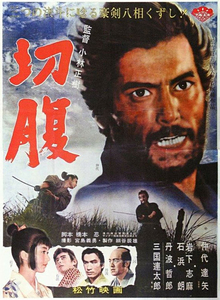Harakiri (1962 film)
| Harakiri | |
|---|---|

Japanese theatrical poster
|
|
| Directed by | Masaki Kobayashi |
| Produced by | Ginichi Kishimoto |
| Screenplay by | Shinobu Hashimoto |
| Based on | "Ibunronin ki" by Yasuhiko Takiguchi |
| Starring | |
| Music by | Toru Takemitsu |
| Cinematography | Yoshio Miyajima |
| Edited by | Hisashi Sagara |
|
Production
companies |
|
|
Release date
|
|
|
Running time
|
134 minutes |
| Country | Japan |
| Language | Japanese |
Harakiri (切腹 Seppuku?, 1962) is a Japanese jidaigeki (period-drama) film directed by Masaki Kobayashi. The story takes place between 1619 and 1630 during the Edo period and the reign of the Tokugawa shogunate. It tells the story of Hanshirō Tsugumo, a warrior without a lord. At the time, it was common for masterless samurai, or rōnin, to request to commit seppuku (hara kiri) in the palace courtyard in the hope of receiving alms from the remaining feudal lords.
Edo, 1630. Tsugumo Hanshirō arrives at the estate of the Ii clan and says that he wishes to commit seppuku within the courtyard of the palace. To deter him Saitō Kageyu (Rentarō Mikuni), the Daimyo's senior counselor, tells Hanshirō the story of another rōnin, Chijiiwa Motome – formerly of the same clan as Hanshirō.
Motome arrived at the palace a few months earlier and made the same request as Hanshirō. Infuriated by the rising number of "suicide bluffs", the three most senior samurai of the clan—Yazaki Hayato, Kawabe Umenosuke, and Omodaka Hikokuro—persuaded Saitō to force Motome to follow through and kill himself. Upon examining Motome's swords, their blades were found to be made of bamboo. Enraged that any samurai would "pawn his soul", the House of Ii forced Motome to disembowel himself with his own bamboo blade, making his death slow, agonizingly painful, and deeply humiliating.
Despite this warning, Hanshirō insists that he has never heard of Motome and says that he has no intention of leaving the Ii palace alive. After a suicide pavilion is set up in the courtyard of the palace, Hanshirō is asked to name the samurai who shall behead him when the ritual is complete. To the shock of Saitō and the Ii retainers, Hanshirō successively names Hayato, Umenosuke, and Hikokuro—the three samurai who coerced the suicide of Motome. When messengers are dispatched to summon them, all three decline to come, saying they are suffering from a life-threatening illness.
...
Wikipedia
